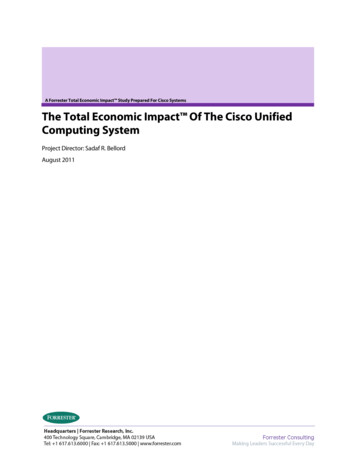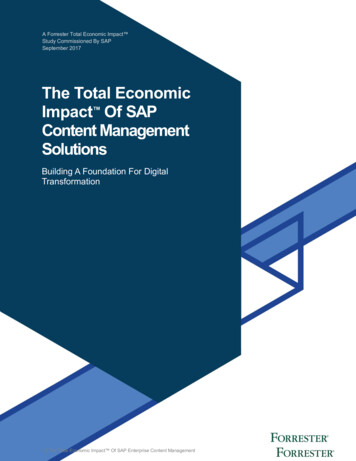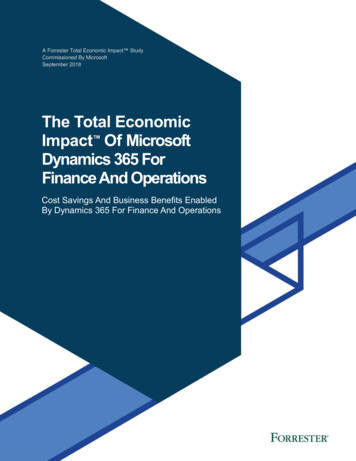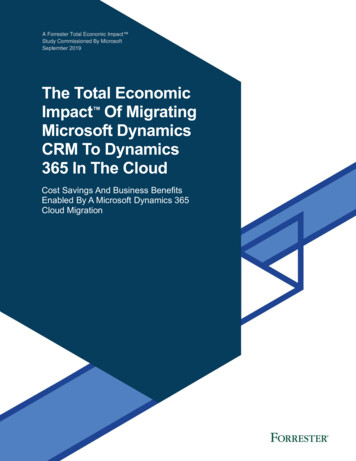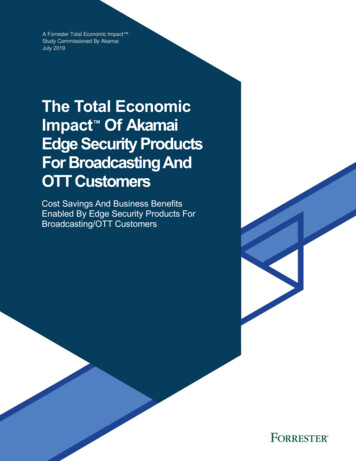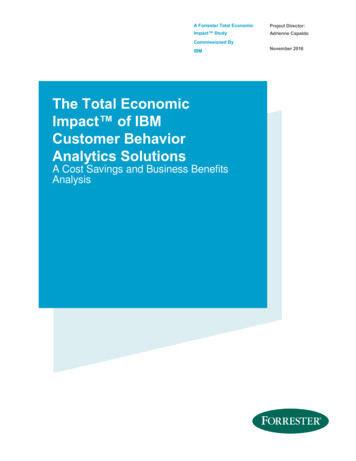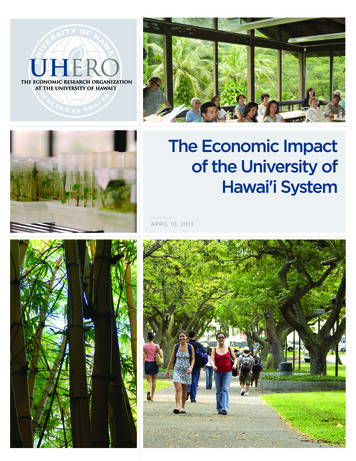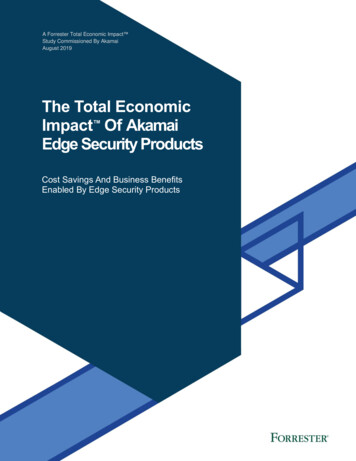
Transcription
A Forrester Total Economic Impact Study Commissioned By AkamaiAugust 2019The Total EconomicImpact Of AkamaiEdge Security ProductsCost Savings And Business BenefitsEnabled By Edge Security Products
Table Of ContentsExecutive SummaryKey Findings11TEI Framework And Methodology3Akamai’s Edge Security Products — A Customer JourneyInterviewed And Surveyed Customers44Key Challenges And Goals4Composite Organization5Key Results5Analysis Of BenefitsBenefit 1: Cost Savings — Fewer FTEs To Support Edge Security66Benefit 2: Revenue Protection Associated With Akamai7Benefit 3: Reduced Spending On Hardware8Benefit 4: Savings From Decommissioning Legacy Software Products8Unquantified Benefits10Flexibility10Costs11Financial SummaryAkamai Edge Security Products: OverviewAppendix A: Total Economic ImpactProject Director:Bob Cormier, Vice Presidentand Principal Consultant121314ABOUT FORRESTER CONSULTINGForrester Consulting provides independent and objective research-basedconsulting to help leaders succeed in their organizations. Ranging in scope from ashort strategy session to custom projects, Forrester’s Consulting services connectyou directly with research analysts who apply expert insight to your specificbusiness challenges. For more information, visit forrester.com/consulting. 2019, Forrester Research, Inc. All rights reserved. Unauthorized reproductionis strictly prohibited. Information is based on best available resources.Opinions reflect judgment at the time and are subject to change. Forrester ,Technographics , Forrester Wave, RoleView, TechRadar, and Total EconomicImpact are trademarks of Forrester Research, Inc. All other trademarks are theproperty of their respective companies. For additional information, go toforrester.com.
Executive SummaryBenefitsRevenue protection: 4.7 millionAkamai commissioned Forrester Consulting to conduct a Total EconomicImpact (TEI) study and examine the potential benefits enterprises mayrealize by deploying the following Akamai edge security products: KonaSite Defender (KSD), Bot Manager, Prolexic Routed, Enterprise ThreatProtector (ETP), and Enterprise Application Access (EAA). The purpose ofthis study is to provide readers with a framework to evaluate the potentialfinancial benefits these Akamai edge security products have onenterprises.To better understand the benefits, risks, and flexibility associated with thisinvestment, Forrester directly interviewed several Akamai customers andsurveyed 30 more customers with experience using Akamai edge securityproducts.For this TEI study, Forrester has created a composite Organization toillustrate the benefits of investing in Akamai’s edge security products.Based on characteristics of the interviewed and surveyed customers, thecomposite Organization is a global, enterprise-sized company with annualrevenues of about 1.5 billion.Decommissioning legacy securityproducts: 125,337Prior to using Akamai’s edge security products, the Organization wasusing a mix of disparate and costly third-party and homegrown securitysolutions.Key FindingsQuantified benefits. The following risk-adjusted present value (PV)benefits total 5,989,705 over three years and are representative of thoseexperienced by the interviewed and surveyed companies:Reduced hardware spend: 149,211› Cost savings — fewer full-time equivalents (FTE) needed to supportAkamai edge security products, 1,052,310. Compared to its preAkamai security environment, the Organization saves 2.5 securityadministrator FTEs in Year 1 (ramp year) and 3.5 FTEs in Years 2 and 3of our analysis.› Revenue protection, 4,662,847. Prior to its investment in Akamai, theOrganization was losing revenue due to inadequate security. Akamaihelps the Organization avoid losing 5% of its revenue and therefore 5%of its resulting gross profit. The 4,662,847 quantified benefit is thegross profit associated with avoiding the loss of revenue.Security FTE savings: 1.1 million› Reduced spending on hardware, 149,211. The Organization wouldhave continued to invest in security infrastructure such as storage,servers, operating system licenses, and annual maintenance to maintainits on-premise legacy security products that were subsequently replacedby Akamai’s edge security products.› Savings from decommissioning legacy security products, 125,337.The Organization decommissions the following legacy security products:distributed denial-of-service (DDoS), bot management solution, virtualprivate network (VPN) services, virtual desktop software subscriptions,and single sign-on (SSO) and multifactor authentication (MFA) services.Unquantified benefits. The interviewed and surveyed customersexperienced the following additional benefits, the monetary value of whichwere not quantified for this study:1 The Total Economic Impact Of Akamai Edge Security Products
› Improved site performance during an attack. Estimated load time (inmilliseconds) of site during an attack was 101.7 milliseconds beforeAkamai and 70 milliseconds with Akamai.› A 5.88% reduction in churn rates and an 11.8% decrease in bouncerates.› An improvement in click-through rates, a 6.3% improvement inconversion rates, and improved customer satisfaction.Forrester: The Impact Of A Breach And The Benefits Of Akamai EdgeSecurity Products› For the 30 customers surveyed, there was an average 65% reduction innumber of data breaches and a 27% reduction in the labor cost forremediating a data breach. Each customer reported sleeping better atnight knowing Akamai was protecting its internet-facing applications andAPIs deployed in their data centers or the public cloud.Forrester’s interviews and surveys with over 35 existing customers andsubsequent financial analysis found that the composite Organizationexperienced benefits of 5,989,705 (present value) over three years.Costs. Interviewed and surveyed customers incurred internal labor costsand Akamai fees associated with their investment in Akamai edge securityproducts. For confidentiality reasons at the request of Akamai, these costsare not quantified in this case study. The cost categories are described inthe Costs section. For more information regarding Akamai fees, pleasecontact your Akamai representative.2 The Total Economic Impact Of Akamai Edge Security Products
TEI Framework And MethodologyFrom the information provided in the interviews, Forrester has constructeda Total Economic Impact (TEI) framework for customers considering aninvestment in Akamai edge security products.The objective of the framework is to identify the benefit, flexibility, and riskfactors that affect the investment decision. Forrester took a multistepapproach to evaluate the impact that Akamai edge security products canhave on the Organization:The TEI methodologyhelps companiesdemonstrate, justify,and realize thetangible value of ITinitiatives to bothsenior managementand other keybusinessstakeholders.DUE DILIGENCEInterviewed Akamai stakeholders and Forrester analysts to gatherdata relative to edge security products.CUSTOMER INTERVIEWS AND SURVEYInterviewed or surveyed over 35 enterprise customers usingAkamai edge security products to obtain data with respect tobenefits risks and flexibility.COMPOSITE ORGANIZATIONDesigned a composite Organization based on characteristics of theinterviewed and surveyed customers.FINANCIAL MODEL FRAMEWORKConstructed a financial model representative of the interviewsusing the TEI methodology and risk-adjusted the financial modelbased on issues and concerns of the interviewed organizations.CASE STUDYEmployed three fundamental elements of TEI in modeling Akamaiedge security products: benefits, risks and flexibility. Given theincreasing sophistication that enterprises have regarding benefitanalyses related to IT investments, Forrester’s TEI methodologyserves to provide a picture of the total economic impact ofpurchase decisions. Please see Appendix A for additionalinformation on the TEI methodology.DISCLOSURESReaders should be aware of the following:This study is commissioned by Akamai and delivered by Forrester Consulting. Itis not meant to be used as a competitive analysis.Forrester makes no assumptions as to the potential benefits that otherorganizations will receive. Forrester strongly advises that readers use their ownestimates within the framework provided in the report to determine theappropriateness of an investment in Akamai edge security products.Akamai reviewed and provided feedback to Forrester, but Forrester maintainseditorial control over the study and its findings and does not accept changes tothe study that contradict Forrester’s findings or obscure the meaning of thestudy.Akamai provided the customer names for the interviews and survey but did notparticipate in the interviews.3 The Total Economic Impact Of Akamai Edge Security Products
Akamai’s Edge Security Products — ACustomer JourneyBEFORE AND AFTER AKAMAI’S EDGE SECURITY PRODUCTSInterviewed And Surveyed CustomersFor this study, Forrester conducted five live interviews and surveyed 30additional Akamai edge security customers. Interviewed and surveyedcustomers were from North America, EMEA, and APAC and included thefollowing attributes:› Enterprise-sized, global customers with average annual revenues inthe 1.5 billion range.› Each customer has used at least two of the following Akamai edgesecurity products for more than six months: KSD, Bot Manager,Prolexic Routed, EAA, and ETP.“Using Akamai edge securityproducts has helped usprovide consistent service tocustomers, even during anattack.”83% of surveyed customers› 77% of surveyed customers use Akamai’s Content Delivery Network(CDN) for website delivery, image delivery, streamed or downloadedvideo, and API traffic.› Prior to Akamai, customers were using either third-party solutions or amix of third-party and homegrown security solutions.INDUSTRYMONTHS USING ad of security engineering12 - 120RetailInternational organizationheadquartered in the USSenior cybersecurity manager48Financial institutionEurope Head of IT infrastructureExecutive vice president12 - 120Educational contentand technologyInternational organizationheadquartered in the US Senior director of customersupportManager, internal systems18 - 48BroadcastingInternational organizationheadquartered in APACHead of cybersecurity andcompliance12 - 8430 surveyedcustomers*VariousVarious12 - 120 *Data from the 30 surveyed customers was used to support theinformation and data from the live, in-depth customer interviews.Key Challenges And GoalsThe interviewed and surveyed customers had the following challengesand goals they were hoping to satisfy with an investment in Akamai edgesecurity products:› To reduce application downtime (and increase application uptime)during malicious attacks.› To protect intellectual property from data breaches.› To protect user accounts from credential stuffing and account takeover.4 The Total Economic Impact Of Akamai Edge Security Products
› To simplify and reduce the cost of their IT security environment.› To protect their brand reputations.Composite OrganizationBased on the interviews, Forrester constructed a TEI framework, acomposite company, and an associated benefit analysis that illustratesthe areas financially affected. The composite Organization isrepresentative of the 35 companies that Forrester interviewed orsurveyed and is used to present the aggregate financial analysis in thenext section. The composite Organization that Forrester synthesizedfrom the customer interviews has the following characteristics:The Organization is a global, enterprise-sized company with annualrevenues of about 1.5 billion.› The Organization uses the following Akamai edge security products:KSD, Bot Manager, Prolexic Routed, EAA, and ETP.› It has been using these products for three years.› An average of 248 applications are protected by Akamai edge securityproducts.› The Organization uses Akamai’s CDN for image delivery, streamed ordownloaded video, website delivery, and API traffic.Key ResultsCustomer interviews and surveys revealed the following quantifiedbenefits from an investment in Akamai’s edge security products:› Cost savings — fewer FTEs needed to support Akamai edgesecurity products. Compared to its pre-Akamai security environment,the Organization saves 2.5 security administrator FTEs in Year 1 (rampyear) and 3.5 FTEs in Years 2 and 3.› Revenue protection. Akamai helps the Organization reduce lostrevenue resulting from application downtime, data breach, web fraud,and brand damage by 5%.“If Akamai’s capabilities were tobe maintained in-house, wewould have to hire, train, andretain substantial andexpensive security resources.We find that it’s more costeffective to use Akamai’sproducts than attempt to hireand retain scarce securitytalent.”Head of security and compliance› Reduced spending on hardware. The Organization would havecontinued to invest in on-premises security infrastructure such asstorage, servers, operating system licenses, and annual maintenanceto maintain its legacy security products that were subsequentlyreplaced by Akamai’s edge security products.› Savings from decommissioning legacy security products. With itsinvestment in Akamai edge security products, the Organizationdecommissions the following legacy security products: DDoS, botmanagement solution, VPN services, and virtual desktop softwaresubscriptions.“Using Akamai edge securityproducts has improvedcustomer satisfaction.”100% of surveyed customers5 The Total Economic Impact Of Akamai Edge Security Products
Analysis Of BenefitsQUANTIFIED BENEFIT DATA AS APPLIED TO THE COMPOSITETotal BenefitsYEAR 1YEAR 2YEAR 3TOTALPRESENTVALUE 337,500 472,500 472,500 1,282,500 1,052,310 1,875,000 1,875,000 1,875,000 5,625,000 4,662,847Reduced spending on hardware 60,000 60,000 60,000 180,000 149,211Savings from decommissioninglegacy security products 50,400 50,400 50,400 151,200 125,337 2,322,900 2,457,900 2,457,900 7,238,700 5,989,705REF.BENEFITAtrCost savings — fewer FTEs tosupport edge securityBtrRevenue protection (gross profit)associated with AkamaiCtrDtrTotal benefits (risk-adjusted)Note: Atr, Btr, Ctr and Dtr refer to risk adjusted totals in the benefit tablesbelow (“r” stands for risk).Benefit 1: Cost Savings — Fewer FTEs To SupportEdge SecurityThe Organization has invested in the full suite of Akamai’s edge securityproducts, including KSD, Bot Manager, Prolexic Routed, ETP, and EAA.Compared to its pre-Akamai security environment, it can now save 2.5security administrator FTEs in Year 1 (ramp year) and 3.5 FTEs in Years2 and 3. Interviewed and surveyed customers reported:The table above shows the total of allbenefits across the areas listed below,as well as present values (PVs)discounted at 10%. Over three years,the composite organization expectsrisk-adjusted total benefits to be a PVof nearly 5.989 million.› A 26.5% reduction in the hours to recover from an attack with Akamai(309 hours before Akamai; 227 hours with Akamai).› A 65% reduction in the number of data breaches and a 27% reductionin the labor cost for remediating a data breach.› A 15% savings in time spent researching and adjusting rule changeswith Akamai edge security products.› Improved ability to protect a broad range of applications from DDoSattacks.› Reduced workload and time to remediate malware infestations.› Reduced time required to provision application access or monitorfirewall login attempts.› Labor savings from no longer having to manage multiple appliances.They manage the configuration in one place, then push it out to allAkamai servers. There’s also a reduction in risk in terms of getting thepolicies correct for multiple appliances.› Labor savings in the reduced volume of attack traffic that Akamaistops, including a reduction in successful attacks to web applications.› Labor savings from Akamai keeping the Organization’s web applicationfirewall (WAF) rules up to date.Risks. Most interviewed and surveyed customers were not yet using thefull complement of Akamai edge security products discussed in this casestudy and therefore reported reduced and variable FTE labor savings.6 The Total Economic Impact Of Akamai Edge Security ProductsImpact risk is the risk that the businessor technology needs of theorganization may not be met by theinvestment, resulting in lower overalltotal benefits. The greater theuncertainty, the wider the potentialrange of outcomes for benefitestimates.
To account for these variations, Forrester adjusted this benefit downwardby 10%, yielding a three-year risk-adjusted total PV of 1,052,310.Cost Savings — Fewer FTEs To Support Edge Security: Calculation TableREF.METRICCALC.A1Before Akamai — security FTEs requiredInterviews999A2With Akamai — security FTEs requiredInterviews6.55.55.5A3With Akamai — FTEs savedA1 - A22.53.53.5A4Average fully loaded cost — security FTEIndustry average 150,000 150,000 150,000AtCost savings — fewer FTEs to support edgesecurityA3 * A4 375,000 525,000 525,000Risk adjustment 10% 337,500 472,500 472,500AtrCost savings — fewer FTEs to support edgesecurity (risk-adjusted)YEAR 1YEAR 2YEAR 3Benefit 2: Revenue Protection Associated WithAkamaiDigital businesses depend on constant, uninterrupted connectivity for thebenefit of their customers. Websites, applications, and cloud services arepotential targets for DDoS and other attacks, which can significantlyharm or even cripple digital businesses.Interviewed and surveyed customers reported the following benefits ofAkamai products, which contribute to preventing revenue loss:› Reduced application downtime from DDoS attacks› Reduced costs associated with remediating data breaches (seecomment below)› Reduced web fraud from bots that engage in credential stuffing,fraudulent free trials and coupons, and other malicious activity.› Protecting their organizations’ intellectual property by redirection ofbots intending to scrape their websites.› Reduced lost web traffic by 7.3% and lost views by 10%.› Reduced lost revenue and resulting gross profit by 5%.Prior to its investment in Akamai, the Organization was losing revenuedue to inadequate edge security. Akamai helps the Organization avoidlosing 5% of its revenue and therefore 5% of its resulting gross profit.The 4,662,847 quantified benefit is the gross profit associated withavoiding the loss of revenue. Forrester estimates the gross profit marginto be an overall industry average of 50%.Risk. The interviewed and surveyed customers had wide ranging totalonline revenues and different gross margin results.To account for these variations, Forrester risk-adjusted this benefitdownward by 25%, yielding a three-year risk-adjusted total PV of 4,662,847.7 The Total Economic Impact Of Akamai Edge Security Products“I feel very confident inAkamai’s ability to protect ourvaluable data from attacks.Akamai is our front door to allissues and our first line ofdefense providing protection,and across our cloudcomputing platform also.”Head of security and compliance
Revenue Protection Associated With Akamai: Calculation TableREF.METRICCALC.YEAR 1B1Estimated lost revenueInterviews 100,000,000 100,000,000 100,000,000B2Reduction in lost revenue (by 5%)B1 * 5% 5,000,000 5,000,000 5,000,000BtRevenue protection (gross profit)associated with AkamaiB2 * 50% 2,500,000 2,500,000 2,500,000Risk adjustment 25% 1,875,000 1,875,000 1,875,000BtrRevenue protection (gross profit)associated with Akamai (risk-adjusted)YEAR 2YEAR 3Benefit 3: Reduced Spending On HardwareInterviewed customers shared their experiences with no longer needingon-premises infrastructure platforms for security products, data,computational power, and engineering services. Forrester assumes theOrganization would have needed to spend 75,000 annually on updatingsecurity infrastructure such as storage, servers, operating systemlicenses, and annual maintenance to maintain its on-premises legacysecurity products that were subsequently replaced by Ak
investment in Akamai edge security products. The objective of the framework is to identify the benefit, flexibility, and risk factors that affect the investment decision. Forrester took a multistep approach to evaluate the impact that Akamai edge security products can have on the Organization: DUE DILIGENCE
